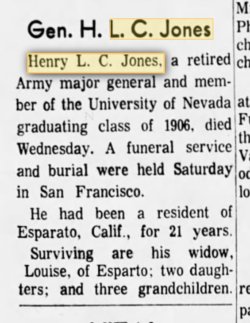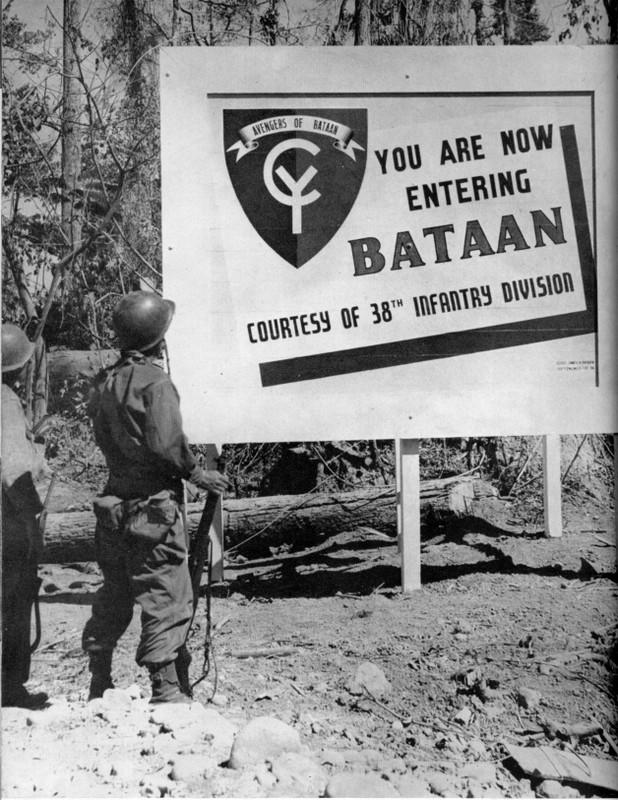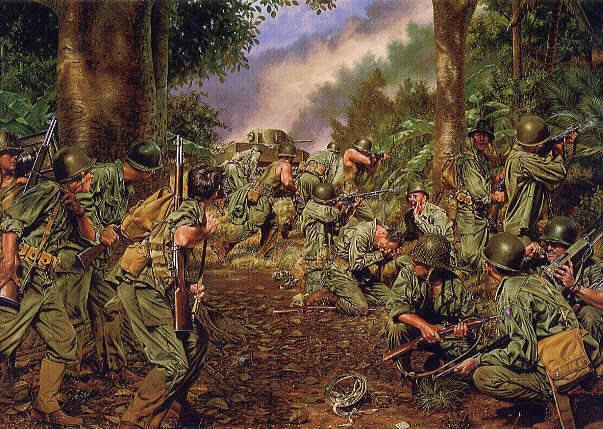Jones commanded 38 Division when it was deployed to Hawaii in January 1944. He led his division in the Philippines.
Service record
1887 Born
September 1, 1932: Assigned to the 11th Field Artillery Brigade in Hawaii as a Major assigned to the 11th FA Bn. (Information from the Field Artillery Journel 1932.)
1939 Colonel Director, Gunnery Department, Field Artillery School
Apr 1942 - Feb 1945 Major General Commander, 38 Infantry Division
1946 Retires
1969 Dies
MG Jones was the third Commanding General (Apr 1942 - Feb 1945) of the 38th Infantry Division and the Commanding General when General McArthur personally dubbed the soldiers of the 38th as the "Avengers of Bataan."
The division first saw action in Leyte December 1944, when the 149th Infantry Regiment was sent into Leyte P. I., for a month of mopping-up campaigning. It then moved on to Luzon, P. I., to make its now famous Subic Bay landing on Bataan Peninsula on 29 January 1945. Division troops poured in for 16 days of fierce action to smash through an intricate maze of Japanese fortifications at Zig-Zag Pass, key defense to the rapid reduction Bataan Peninsula. While one division regimental combat team made an amphibious landing at Mariveles, on the tip of the Peninsula, another force struck swiftly down the east coast through Balanga, Pilar and across the neck of land to Bagac the March of Death route – - to gain control of the entire peninsula. Some units of the 38th then landed at D plus 4, on Corregidor to assist in the defeat of the strong Jap garrison there. The division was then divided up into three regiment combat teams. One force mopped up remnants of enemy troops on the Bataan Peninsula. Another regimental combat team plus a provisional company organized from the 38th division artillery, struck north and west of Zig-Zag Pass against powerful Jap defense in the Zambales mountain ranges, while the third regimental combat team was charged with the reduction of enemy defenses on the remaining three islands – - Cabello, Fort Drum and Carabao – - guarding the entrance to Manila Bay. Later sent to the Marakina watershed, the Cyclone boys worked in May 1945, to free Eastern Luzon from the Gaps and helped preserve Manila's water supply. This involved fighting in the Sierra Madre mountains northeast of Manila to oppose Jap forces drawn up behind the Shinbu Line, an area defended by almost impassable terrain in addition to a well developed and interlocking series of caves, pillboxes, tunnels and artillery emplacements. Here division troops defeated the Japanese in a series of bitterly contested engagements culminating in the seizing of the Marakina River line and the capture of strategic Wawa Dam, an important source of water supply to Manila. Division troops engaged in combat with the Japs in the bamboo thickets and mountainous terrain of the Marakina area up to and after V-J Day.
Information from The Pacific War Online Encyclopedia (c) 2008 by Kent G. Budge and The Fact Sheet of the 38th Infantry Division - These Army Ground Forces Fact Sheets were prepared at the end of the war (1 March 1947) by The Information Section, Analysis Branch, Headquarters Army Ground Forces on each division. They may be found in Record Group 407, Unit Records, for each division, under the file number 3 (Division #) - 0 at the National Archives and Records Administration, 8601 Adelphi Rd, College Park MD.
-------------------------------
The 38th Infantry Division's primary objectives were to execute a supporting amphibious attack on the western shore of Luzon, to drive eastward across the north neck of the Bataan Peninsula, to seal it off from the Japanese coming down from the north, and to clear the peninsula of all enemy forces and to retake it totally.
The division and companion 34th Regimental Combat Team (RCT) landed on 29 January 1945 just north of Subic Bay. (Insert map #5-XI Corps Landing). Good progress was made driving eastward until the third day. In the midst of twisting jungle trails, well prepared and protected enemy strong points, honey-combed tunnels and trenches linking concealed foxholes, log and dirt pillboxes from which fire covered every avenue of movement, and inability to see but a few feet ahead, the division ran into a strongpoint that would soon be known as Horseshoe Bend.
It was the first of a major set of obstacles in what became known as the battle for Zig Zag Pass.
The "Avengers of Bataan," struggled in February 1945 to open Highway 7 through ZigZag Pass. Possession of this road, running between Subie Bay and Manila, was vital to the liberation of Bataan. The operation was so significant that General Doulgas MacArthur personally dubbed the soldiers of the 38th as the "Avengers of Bataan."
They accepted it with pride and proclaimed it with signs, it appeared in news articles, an unofficial tab was made for wear above the CY shoulder sleeve insignia, and it is frequently mentioned in Southwest Pacific was histories. Although the War Department/Department of Defense never acknowledged it as an unofficial nickname, it is still used unofficially in direct association with the 38th.
Jones commanded 38 Division when it was deployed to Hawaii in January 1944. He led his division in the Philippines.
Service record
1887 Born
September 1, 1932: Assigned to the 11th Field Artillery Brigade in Hawaii as a Major assigned to the 11th FA Bn. (Information from the Field Artillery Journel 1932.)
1939 Colonel Director, Gunnery Department, Field Artillery School
Apr 1942 - Feb 1945 Major General Commander, 38 Infantry Division
1946 Retires
1969 Dies
MG Jones was the third Commanding General (Apr 1942 - Feb 1945) of the 38th Infantry Division and the Commanding General when General McArthur personally dubbed the soldiers of the 38th as the "Avengers of Bataan."
The division first saw action in Leyte December 1944, when the 149th Infantry Regiment was sent into Leyte P. I., for a month of mopping-up campaigning. It then moved on to Luzon, P. I., to make its now famous Subic Bay landing on Bataan Peninsula on 29 January 1945. Division troops poured in for 16 days of fierce action to smash through an intricate maze of Japanese fortifications at Zig-Zag Pass, key defense to the rapid reduction Bataan Peninsula. While one division regimental combat team made an amphibious landing at Mariveles, on the tip of the Peninsula, another force struck swiftly down the east coast through Balanga, Pilar and across the neck of land to Bagac the March of Death route – - to gain control of the entire peninsula. Some units of the 38th then landed at D plus 4, on Corregidor to assist in the defeat of the strong Jap garrison there. The division was then divided up into three regiment combat teams. One force mopped up remnants of enemy troops on the Bataan Peninsula. Another regimental combat team plus a provisional company organized from the 38th division artillery, struck north and west of Zig-Zag Pass against powerful Jap defense in the Zambales mountain ranges, while the third regimental combat team was charged with the reduction of enemy defenses on the remaining three islands – - Cabello, Fort Drum and Carabao – - guarding the entrance to Manila Bay. Later sent to the Marakina watershed, the Cyclone boys worked in May 1945, to free Eastern Luzon from the Gaps and helped preserve Manila's water supply. This involved fighting in the Sierra Madre mountains northeast of Manila to oppose Jap forces drawn up behind the Shinbu Line, an area defended by almost impassable terrain in addition to a well developed and interlocking series of caves, pillboxes, tunnels and artillery emplacements. Here division troops defeated the Japanese in a series of bitterly contested engagements culminating in the seizing of the Marakina River line and the capture of strategic Wawa Dam, an important source of water supply to Manila. Division troops engaged in combat with the Japs in the bamboo thickets and mountainous terrain of the Marakina area up to and after V-J Day.
Information from The Pacific War Online Encyclopedia (c) 2008 by Kent G. Budge and The Fact Sheet of the 38th Infantry Division - These Army Ground Forces Fact Sheets were prepared at the end of the war (1 March 1947) by The Information Section, Analysis Branch, Headquarters Army Ground Forces on each division. They may be found in Record Group 407, Unit Records, for each division, under the file number 3 (Division #) - 0 at the National Archives and Records Administration, 8601 Adelphi Rd, College Park MD.
-------------------------------
The 38th Infantry Division's primary objectives were to execute a supporting amphibious attack on the western shore of Luzon, to drive eastward across the north neck of the Bataan Peninsula, to seal it off from the Japanese coming down from the north, and to clear the peninsula of all enemy forces and to retake it totally.
The division and companion 34th Regimental Combat Team (RCT) landed on 29 January 1945 just north of Subic Bay. (Insert map #5-XI Corps Landing). Good progress was made driving eastward until the third day. In the midst of twisting jungle trails, well prepared and protected enemy strong points, honey-combed tunnels and trenches linking concealed foxholes, log and dirt pillboxes from which fire covered every avenue of movement, and inability to see but a few feet ahead, the division ran into a strongpoint that would soon be known as Horseshoe Bend.
It was the first of a major set of obstacles in what became known as the battle for Zig Zag Pass.
The "Avengers of Bataan," struggled in February 1945 to open Highway 7 through ZigZag Pass. Possession of this road, running between Subie Bay and Manila, was vital to the liberation of Bataan. The operation was so significant that General Doulgas MacArthur personally dubbed the soldiers of the 38th as the "Avengers of Bataan."
They accepted it with pride and proclaimed it with signs, it appeared in news articles, an unofficial tab was made for wear above the CY shoulder sleeve insignia, and it is frequently mentioned in Southwest Pacific was histories. Although the War Department/Department of Defense never acknowledged it as an unofficial nickname, it is still used unofficially in direct association with the 38th.
Family Members
Sponsored by Ancestry
Advertisement
Advertisement






